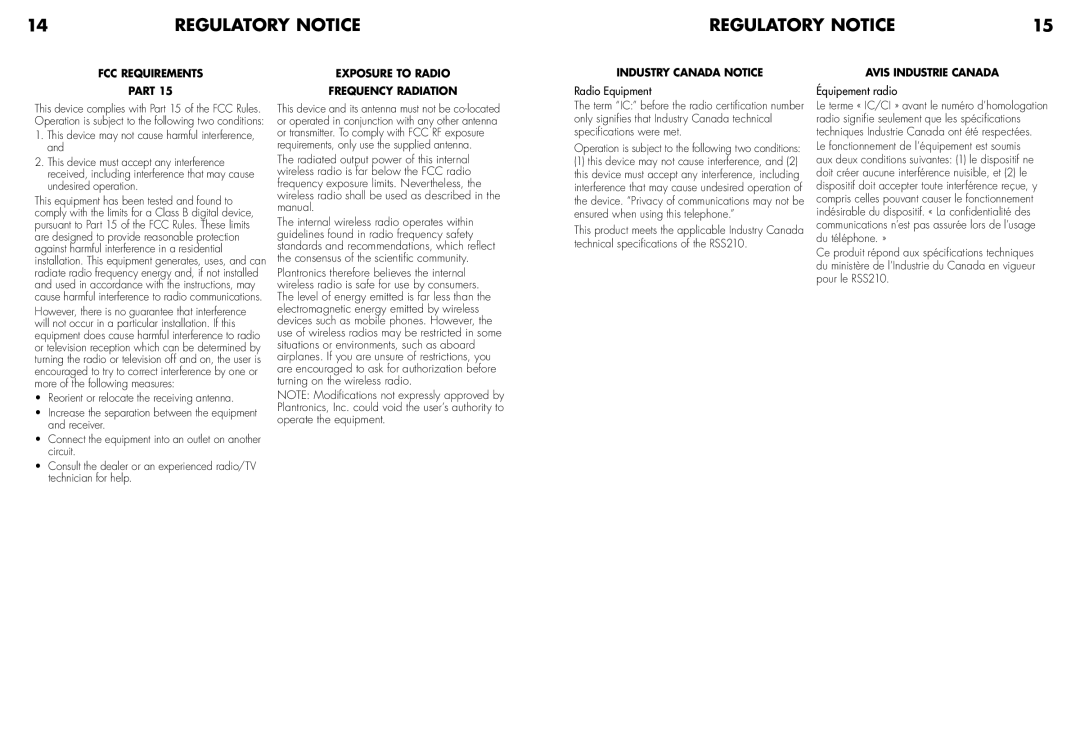14 | Regulatory Notice |
Regulatory Notice | 15 |
FCC reQUIREMENTS | EXPOSURE TO RADIO |
PART 15 | FREQUENCY RADIATION |
INDUSTRY CANADA NOTICE
Radio Equipment
AVIS INDUSTRIE CANADA
Équipement radio
This device complies with Part 15 of the FCC Rules. Operation is subject to the following two conditions:
1.This device may not cause harmful interference, and
2.This device must accept any interference received, including interference that may cause undesired operation.
This equipment has been tested and found to comply with the limits for a Class B digital device, pursuant to Part 15 of the FCC Rules. These limits are designed to provide reasonable protection against harmful interference in a residential installation. This equipment generates, uses, and can radiate radio frequency energy and, if not installed and used in accordance with the instructions, may cause harmful interference to radio communications.
However, there is no guarantee that interference will not occur in a particular installation. If this equipment does cause harmful interference to radio or television reception which can be determined by turning the radio or television off and on, the user is encouraged to try to correct interference by one or more of the following measures:
•Reorient or relocate the receiving antenna.
•Increase the separation between the equipment and receiver.
•Connect the equipment into an outlet on another circuit.
•Consult the dealer or an experienced radio/TV technician for help.
This device and its antenna must not be
The radiated output power of this internal wireless radio is far below the FCC radio frequency exposure limits. Nevertheless, the wireless radio shall be used as described in the manual.
The internal wireless radio operates within guidelines found in radio frequency safety standards and recommendations, which reflect the consensus of the scientific community.
Plantronics therefore believes the internal wireless radio is safe for use by consumers. The level of energy emitted is far less than the electromagnetic energy emitted by wireless devices such as mobile phones. However, the use of wireless radios may be restricted in some situations or environments, such as aboard airplanes. If you are unsure of restrictions, you are encouraged to ask for authorization before turning on the wireless radio.
NOTE: Modifications not expressly approved by Plantronics, Inc. could void the user’s authority to operate the equipment.
The term “IC:” before the radio certification number only signifies that Industry Canada technical specifications were met.
Operation is subject to the following two conditions:
(1)this device may not cause interference, and (2) this device must accept any interference, including interference that may cause undesired operation of the device. “Privacy of communications may not be ensured when using this telephone.”
This product meets the applicable Industry Canada technical specifications of the RSS210.
Le terme « IC/CI » avant le numéro d’homologation radio signifie seulement que les spécifications techniques Industrie Canada ont été respectées.
Le fonctionnement de l’équipement est soumis aux deux conditions suivantes: (1) le dispositif ne doit créer aucune interférence nuisible, et (2) le dispositif doit accepter toute interférence reçue, y compris celles pouvant causer le fonctionnement indésirable du dispositif. « La confidentialité des communications n’est pas assurée lors de l’usage du téléphone. »
Ce produit répond aux spécifications techniques du ministère de l’Industrie du Canada en vigueur pour le RSS210.
